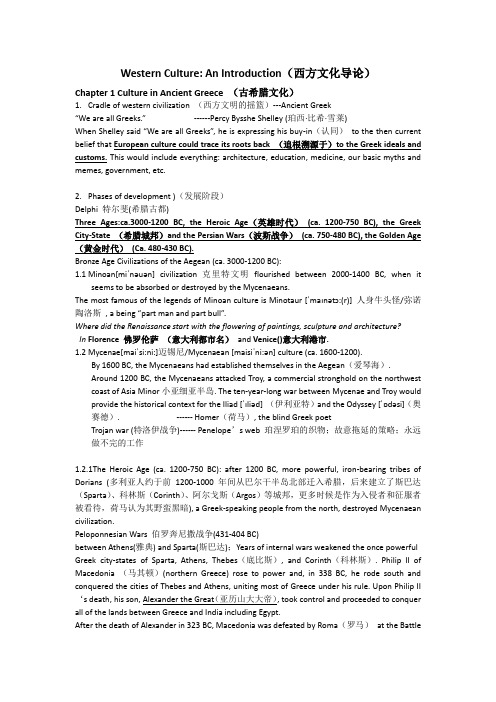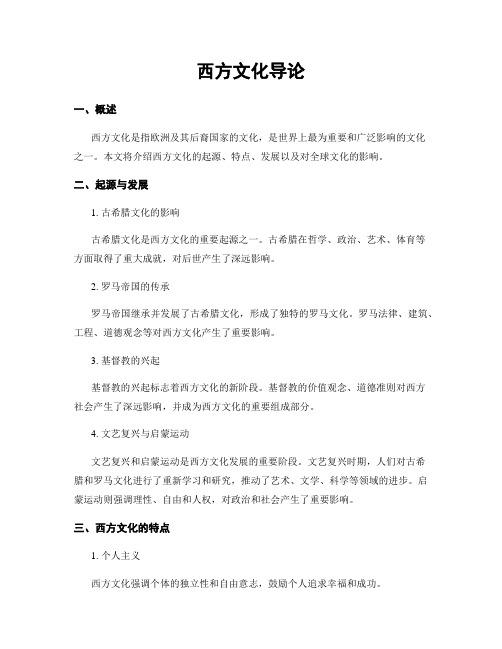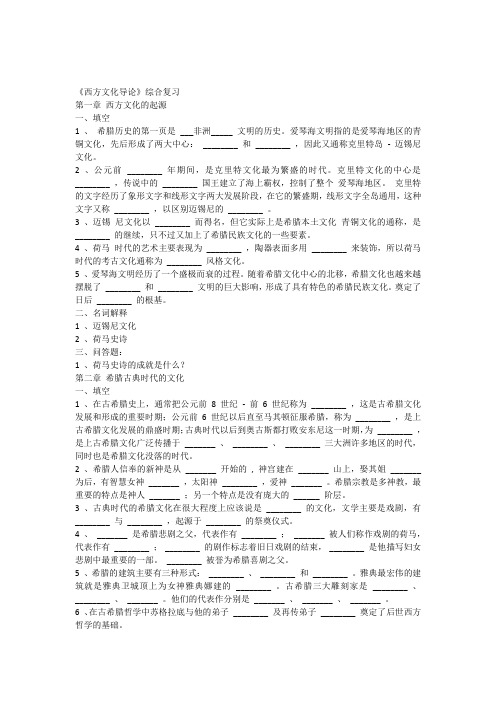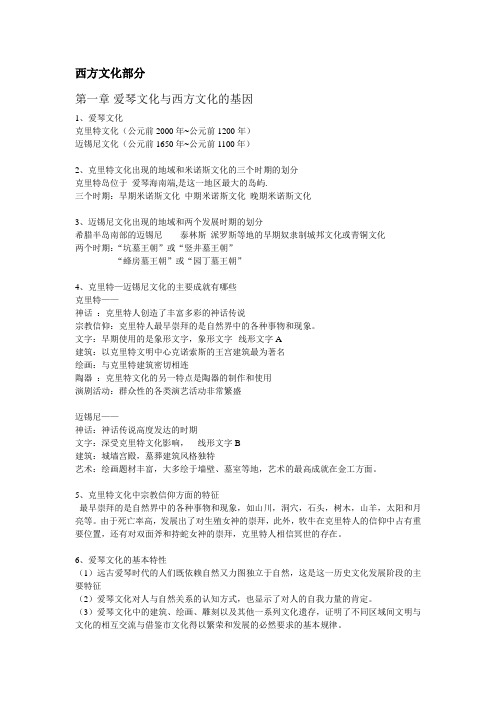西方文化导论1
西方文化导论

Western Culture: An Introduction(西方文化导论)Chapter 1 Culture in Ancient Greece (古希腊文化)1.Cradle of western civilization (西方文明的摇篮)---Ancient Greek“We are all Greeks.”------Percy Bysshe Shelley (珀西·比希·雪莱)When Shelley said “We are all Greeks”, he is expressing his buy-in(认同)to the then current belief that European culture could trace its roots back (追根溯源于)to the Greek ideals and customs. This would include everything: architecture, education, medicine, our basic myths and memes, government, etc.2.Phases of development )(发展阶段)Delphi 特尔斐(希腊古都)Three Ages:ca.3000-1200 BC, the Heroic Age(英雄时代)(ca. 1200-750 BC), the Greek City-State (希腊城邦)and the Persian Wars(波斯战争)(ca. 750-480 BC), the Golden Age (黄金时代)(Ca. 480-430 BC).Bronze Age Civilizations of the Aegean (ca. 3000-1200 BC):1.1Minoan[miˈnəuən] civilization 克里特文明flourished between 2000-1400 BC, when itseems to be absorbed or destroyed by the Mycenaeans.The most famous of the leg ends of Minoan culture is Minotaur [ˈmaɪnətɔ:(r)] 人身牛头怪/弥诺陶洛斯, a being “part man and part bull”.Where did the Renaissance start with the flowering of paintings, sculpture and architecture?In Florence 佛罗伦萨(意大利都市名)and Venice()意大利港市.1.2Mycenae[maiˈsi:ni:]迈锡尼/Mycenaean [maisiˈni:ən] culture (ca. 1600-1200).By 1600 BC, the Mycenaeans had established themselves in the Aegean(爱琴海).Around 1200 BC, the Mycenaeans attacked Troy, a commercial stronghold on the northwest coast of Asia Minor小亚细亚半岛. The ten-year-long war between Mycenae and Troy would provide the historical context for the Iliad [ˈɪliəd] (伊利亚特)and the Odyssey [ˈɒdəsi](奥赛德). ------ Homer(荷马), the blind Greek poetTrojan war (特洛伊战争)------ Penelope’s web 珀涅罗珀的织物;故意拖延的策略;永远做不完的工作1.2.1The Heroic Age (ca. 1200-750 BC): after 1200 BC, more powerful, iron-bearing tribes of Dorians (多利亚人约于前1200-1000年间从巴尔干半岛北部迁入希腊,后来建立了斯巴达(Sparta)、科林斯(Corinth)、阿尔戈斯(Argos)等城邦,更多时候是作为入侵者和征服者被看待,荷马认为其野蛮黑暗), a Greek-speaking people from the north, destroyed Mycenaean civilization.Peloponnesian Wars 伯罗奔尼撒战争(431-404 BC)between Athens(雅典) and Sparta(斯巴达);Years of internal wars weakened the once powerful Greek city-states of Sparta, Athens, Thebes(底比斯), and Corinth(科林斯). Philip II of Macedonia (马其顿)(northern Greece) rose to power and, in 338 BC, he rode south and conquered the cities of Thebes and Athens, uniting most of Greece under his rule. Upon Philip II ‘s death, his son, Alexander the Great(亚历山大大帝), took control and proceeded to conquer all of the lands between Greece and India including Egypt.After the death of Alexander in 323 BC, Macedonia was defeated by Roma(罗马)at the Battleof Cynoscephalae(基诺斯山战役)in 197 BC and then again at the Battle of Pydna(皮德纳战役)in 168 BC. The Greeks were finally defeated at the Battle of Corinth in 146 BC. Rome completely destroyed and plundered(掠夺)the city of Corinth as an example to other Greek cities.1.2.2The Greek City-State and the Persian Wars (ca. 750-480 BC)In 490 BC, Battle of Marathon 马拉松战役In 480 BC, Battle of the Hot Gates and Battle of Salamis 萨拉米斯海战Persian Wars(希波战争): Herodotus 希罗多德(ca. 485-425 BC), the father of history 历史之父。
西方文化导论Unit1PPT精品文档

Comprehension Exercises
Multiple choice. (4) The Trojan War broke out at the end of ____.
Text Study
Comprehension Exercises
A. the Heroic Age B. the Golden Age C. the Cretan Civilization D. the Mycenaean Civilization
(1) Draco (2) Cleisthenes (3) Peisistratus (4) Solon (5) Pericles
a. supreme council check the behavior of leaders
b. punish trivial crimes with the death sentence
Text Study
Comprehension Exercises
_F_ (1) The play Oedipus at Colonus was written by Aristophanes. _F_ (2) Greek philosophy started with Aristotle. _T_ (3) The famous bronze sculpture of athletes, Discus Thrower,
Aristotle.
Comprehension Exercises
Multiple choice.
Text Study
Comprehension Exercises
(5) The first Olympiad began in the ____ period of the Golden Age.
Unit10西方文化导论课件

Get Started
In a way the change of the cultural and intellectual climate in this period had something to do with romanticism and cultural trend of the time. More radical modes of creation appeared, first in poetry and then spread to other forms of writing and art. They were more rebellious, more radical, more opposed to tradition and social reality and more concerned with their own forms of subjective representation. Such a changed approach moved eventually into modernism.
Get Started
Modernism was born at the turn of the 20th century and swept many countries. Many social and psychological problems found expression in cultural and literary form, thus representing the real mood and emotion of the ordinary people in the West who were torn by countless troubles arising out of the social, political and cultural contradictions and clashes.
西方文化导论

西方文化导论一、概述西方文化是指欧洲及其后裔国家的文化,是世界上最为重要和广泛影响的文化之一。
本文将介绍西方文化的起源、特点、发展以及对全球文化的影响。
二、起源与发展1. 古希腊文化的影响古希腊文化是西方文化的重要起源之一。
古希腊在哲学、政治、艺术、体育等方面取得了重大成就,对后世产生了深远影响。
2. 罗马帝国的传承罗马帝国继承并发展了古希腊文化,形成了独特的罗马文化。
罗马法律、建筑、工程、道德观念等对西方文化产生了重要影响。
3. 基督教的兴起基督教的兴起标志着西方文化的新阶段。
基督教的价值观念、道德准则对西方社会产生了深远影响,并成为西方文化的重要组成部分。
4. 文艺复兴与启蒙运动文艺复兴和启蒙运动是西方文化发展的重要阶段。
文艺复兴时期,人们对古希腊和罗马文化进行了重新学习和研究,推动了艺术、文学、科学等领域的进步。
启蒙运动则强调理性、自由和人权,对政治和社会产生了重要影响。
三、西方文化的特点1. 个人主义西方文化强调个体的独立性和自由意志,鼓励个人追求幸福和成功。
2. 科学与技术的重视西方文化崇尚科学与技术的发展,注重实证主义和理性思维,推动了现代科学的进步。
3. 民主与法治西方文化倡导民主政治和法治社会,注重个人权利和平等,推动了现代民主制度的发展。
4. 艺术与文学的创新西方文化在艺术与文学领域具有创新精神,不断探索新的表达形式和艺术风格。
四、西方文化对全球的影响1. 语言和文学英语作为西方文化的代表语言,成为国际交流和商务的重要工具。
西方文学作品如莎士比亚的戏剧、浪漫主义文学等对全球文学产生了深远影响。
2. 科学与技术西方文化的科学与技术成果对全球产生了广泛影响,如工业革命、电子技术、计算机科学等。
3. 政治与法律西方文化的民主制度和法治观念对全球政治和法律体系的发展产生了重要影响。
4. 艺术与娱乐西方音乐、电影、时尚等艺术与娱乐形式在全球范围内受到广泛欢迎,成为全球流行文化的一部分。
五、结论西方文化作为世界上最重要和广泛影响的文化之一,其起源、发展、特点以及对全球的影响都具有重要意义。
西方文化导论Unit

5. _P_o_p_a_r_t_ intends to set up a style of impersonality by employing the imagery of commercialized art or other art forms of the mass media.
Text Study
Comprehension Exercises
Multiple choice.
(1) Impressionism got its name from ________famous painting Impression: Sunrise.
A. Pissarro’s B. Monet’s C. van Gogh’s D. Paul Gauguin’s
_T_ 5. Jazz was initially influenced by two kinds of Negro music: ragtime and blues.
Comprehension Exercises
Text Study
Comprehension Exercises
Fill in the blanks.
_T_ 3. The role of TV is an important link between the individual
and the public or social side of life.
_F_ 4. The major four Western agencies are: Associated Press, BBC, Reuters and Press de France Nouvelle.
_fa_u_v_i_s_m_ and expressionism.
《西方文化导论》复习综合题库

《西方文化导论》综合复习第一章西方文化的起源一、填空1 、希腊历史的第一页是___非洲_____ 文明的历史。
爱琴海文明指的是爱琴海地区的青铜文化,先后形成了两大中心:________ 和________ ,因此又通称克里特岛- 迈锡尼文化。
2 、公元前________ 年期间,是克里特文化最为繁盛的时代。
克里特文化的中心是________ ,传说中的________ 国王建立了海上霸权,控制了整个爱琴海地区。
克里特的文字经历了象形文字和线形文字两大发展阶段,在它的繁盛期,线形文字全岛通用,这种文字又称________ ,以区别迈锡尼的________ 。
3 、迈锡尼文化以________ 而得名,但它实际上是希腊本土文化青铜文化的通称,是________ 的继续,只不过又加上了希腊民族文化的一些要素。
4 、荷马时代的艺术主要表现为________ ,陶器表面多用________ 来装饰,所以荷马时代的考古文化通称为________ 风格文化。
5 、爱琴海文明经历了一个盛极而衰的过程。
随着希腊文化中心的北移,希腊文化也越来越摆脱了________ 和________ 文明的巨大影响,形成了具有特色的希腊民族文化。
奠定了日后________ 的根基。
二、名词解释1 、迈锡尼文化2 、荷马史诗三、问答题:1 、荷马史诗的成就是什么?第二章希腊古典时代的文化一、填空1 、在古希腊史上,通常把公元前8 世纪- 前6 世纪称为________ ,这是古希腊文化发展和形成的重要时期;公元前6 世纪以后直至马其顿征服希腊,称为________ ,是上古希腊文化发展的鼎盛时期;古典时代以后到奥古斯都打败安东尼这一时期,为________ ,是上古希腊文化广泛传播于_______ 、________ 、________ 三大洲许多地区的时代,同时也是希腊文化没落的时代。
2 、希腊人信奉的新神是从_______ 开始的, 神宫建在_______ 山上,娶其姐_______ 为后,有智慧女神_______ ,太阳神________ ,爱神_______ 。
外国文化导论

西方文化部分第一章爱琴文化与西方文化的基因1、爱琴文化克里特文化(公元前2000年~公元前1200年)迈锡尼文化(公元前1650年~公元前1100年)2、克里特文化出现的地域和米诺斯文化的三个时期的划分克里特岛位于爱琴海南端,是这一地区最大的岛屿.三个时期:早期米诺斯文化中期米诺斯文化晚期米诺斯文化3、迈锡尼文化出现的地域和两个发展时期的划分希腊半岛南部的迈锡尼泰林斯派罗斯等地的早期奴隶制城邦文化或青铜文化两个时期:“坑墓王朝”或“竖井墓王朝”“蜂房墓王朝”或“园丁墓王朝”4、克里特—迈锡尼文化的主要成就有哪些克里特——神话:克里特人创造了丰富多彩的神话传说宗教信仰:克里特人最早崇拜的是自然界中的各种事物和现象。
文字:早期使用的是象形文字,象形文字--线形文字A建筑:以克里特文明中心克诺索斯的王宫建筑最为著名绘画:与克里特建筑密切相连陶器:克里特文化的另一特点是陶器的制作和使用演剧活动:群众性的各类演艺活动非常繁盛迈锡尼——神话:神话传说高度发达的时期文字:深受克里特文化影响,线形文字B建筑:城墙宫殿,墓葬建筑风格独特艺术:绘画题材丰富,大多绘于墙壁、墓室等地,艺术的最高成就在金工方面。
5、克里特文化中宗教信仰方面的特征最早崇拜的是自然界中的各种事物和现象,如山川,洞穴,石头,树木,山羊,太阳和月亮等。
由于死亡率高,发展出了对生殖女神的崇拜,此外,牧牛在克里特人的信仰中占有重要位置,还有对双面斧和持蛇女神的崇拜,克里特人相信冥世的存在。
6、爱琴文化的基本特性(1)远古爱琴时代的人们既依赖自然又力图独立于自然,这是这一历史文化发展阶段的主要特征(2)爱琴文化对人与自然关系的认知方式,也显示了对人的自我力量的肯定。
(3)爱琴文化中的建筑、绘画、雕刻以及其他一系列文化遗存,证明了不同区域间文明与文化的相互交流与借鉴市文化得以繁荣和发展的必然要求的基本规律。
第二章古代希腊文化1、重要的政治家思想家科学家文学家和其他文化代表人物及其代表性著作代表性观点以及经典性语录苏格拉底认为,人最迫切的任务是认识自己柏拉图是其学生,他认为,万物的本原是超越感觉的永恒的理念。
西方文化导论人物对应的思想理论

西方文化导论人物对应的思想理论一、古希腊(小国寡民,城邦,民主,伦理)(一)苏格拉底1、知识即美德2、应由智者管理国家(二)柏拉图1、君主制,哲学王2、三大阶级:统治者、护卫者、生产者3、人治4、普及教育5、消灭私有财产,共妻共子(三)亚里士多德1、人是天生的政治动物2、城邦是最高的善3、批判柏拉图4、有限的私有财产5、肯定中产阶级的作用6、主张中庸的民主制度(混合政体)7、法治二、希腊化时代与古罗马(移民部落文化,法治,公民权扩大,血缘联系较弱)(一)伊壁鸠鲁学派1、快乐主义(直面死亡、不惧神、节欲、精神快乐、忍受痛苦)2、不参与政治3、享受灵魂安宁与社会安全4、国家产生于契约5、正义在于互利(二)犬儒学派1、享乐是恶2、抛弃家庭3、拒绝文明4、远离政治5、精神自由6、人人平等(三)斯多葛学派1、世界是一个整体,自然法,世界主义2、人人平等3、清心寡欲4、国家是自然的产物(四)波里比阿1、认为政体是循环的2、主张混合政体3、三权分立(执政官、元老院、民众大会)(五)西塞罗1、强调国家,突破传统城邦界限2、法治3、人人平等4、混合政体5、自然法(六)奥古斯丁1、人的原罪与上帝的恩典2、双城:天上之城与地上之城3、国家的工具性4、国家与教会的关系三、中世纪(王权与教权)教权派思想:1、尼古拉一世(教会独立,国家不得干涉教会);2、格里高利七世(教会高于国家,教会永不犯错);3、英诺森三世(教会是完整社会);4、卜尼法斯八世(两剑论,王权服务于教权)(一)阿奎那1、承认国家的存在,但教会高于国家2、国家的起源是人有群居习性,需要指导、照顾和控制,国家的目的是谋取社会的共同幸福3、正义政体(一个自由人的社会是在为公众谋幸福的统治者的治理下)与不正义政体(统治者谋取私利)4、永恒法、自然法、人法和神法5、真正的幸福不能在物质欲望中实现四、16世纪西欧(一)马基雅维利1、国家是因为人性恶而产生的2、财产是国家生活的重要内容3、统治权是国家的根本问题4、法律与军队是统治权的基础5、主张政治与道德分离6、君主制是最现实的7、君主不受道德约束,可以不守信,不择手段,应使人民恐惧(二)马丁路德1、反对救赎,倡导因信得救2、否定教会中介3、主张廉价的民族教会4、两个政府理论5、主张君主制(三)加尔文1、《圣经》是唯一信仰权威2、主张预定论3、取消教皇与主教4、建立民主的教会组织5、教会与俗世权力分界分明6、主张贵族制(四)布丹1、接受亚里士多德的历史国家观2、家庭是国家的基础,代表公、私两大领域3、国家与社会之上有神法和自然法的权威4、公民分等级,对主权者负有忠诚和服从的义务5、国家目的是要满意人民在物质和非物质上的需要:福利、秩序和道德追求6、坚持国家主权(立法权是首先内容。
- 1、下载文档前请自行甄别文档内容的完整性,平台不提供额外的编辑、内容补充、找答案等附加服务。
- 2、"仅部分预览"的文档,不可在线预览部分如存在完整性等问题,可反馈申请退款(可完整预览的文档不适用该条件!)。
- 3、如文档侵犯您的权益,请联系客服反馈,我们会尽快为您处理(人工客服工作时间:9:00-18:30)。
Text Study
Supplementary Resources
Get Started
Get Started
1. A General Introduction 2. Focus In
Get Started
Get Started
Greek culture dates back to the Neolithic Age (about 4000 BC). By its Bronze Age (about 2800 BC), Greek culture had come to a stage of substantial development in view of its ability to produce useful tools and articles and weapons in bronze, as were evidenced by the unearthed artifacts in the neighborhood of the Aegean Sea. The Aegean Civilization or the Stone and Bronze Age Civilization was thus shaped and included Cretan Civilization and Mycenaean Civilization, which appeared subsequently, with a high level of cultural development, as was demonstrated in its architecture, art and crafts as well as the pictographic script which had been used widely.
Text Study
Comprehension Exercises
Comprehension Exercises
Multiple choice. (1) ____ is the major foundation in the Western culture and makes a powerful impact on the development of human civilization.
Stage 1: PreCretan historical Civilization Age (5000 years ago)
Text Study
Main Ideas
Main Ideas
Stage 2: Mycenae was a country where slaves Mycenaean were commonly used in agricultural PreCivilization and handicraft production. Mycenaean historical culture benefited much from Cretan (ended in Age the 12th culture on its social and economic century BC) development. The period is between the coming of the Greeks to Thessaly and the Greeks’ returning from Troy and Heroic culminates in the Trojan War. The Trojan War had Age helped to produce two famous epics, Odyssey and Iliad.
Get Started
To get a brief view of the history and development of Greek Civilization To be familiar with Greek culture in mythology, religion, philosophy, history, literature and arts To know some representative philosophers and their contributions
Text Study
Interpretation of Cultural Terms
Interpretation of Cultural Terms
Minos 米诺斯: In Greek mythology, Minos was a king of Crete, son of Zeus and Europa. After his death, Minos became a judge of the dead in Hades. The Minoan Civilization of pre-Hellene Crete has been named after him by the archaeologist Arthur Evans.
Get Started
Historically, Greek culture is of a rich variety, lasting value and wide influence around the world. Under the administration of the city government and its stimulation on cultural exchange, cultural prosperity rose up in architecture, philosophy, literature, arts and sports. Such an intellectual climate hence led to the emergence of a number of famous philosophers, artists and historians who produced their remarkable contributions to Greek Civilization.
Multiple choice. (2) Greek culture can date back to____.
A. the Neolithic Age
B. the Bronze Age
C. the Stone and Bronze Age
D. the Old Stone Age
Text Study
A. Ancient European culture
B. Ancient Greek culture
C. Ancient Chinese culture
D. Ancient Egyptian culture
Text Study
Comprehension Exercises
Comprehension Exercises
Text Study
Interpretation of Cultural Terms
Interpretation of Cultural Terms
The Neolithic 新石器时代: It is a period in the development of human technology, beginning in about 9500 BC in the Middle East that is traditionally considered the last part of the Stone Age. The Neolithic is a measured progression of behavioral and cultural characteristics and changes, including the use of wild and domestic crops and the use of domesticated animals.
C. religion
D. philosophy
Text Study
Comprehension Exercises
Comprehension Exercises
Multiple choice. (4) The Trojan War broke out at the end of ____.
Main Ideas
Ages
Stages
Characters & Cultural Achievements
2600 BC–2000 BC, the Neolithic
2000 BC–1600 BC, social classes appeared; Minos-a unified country from smaller city-states. During 1600 BC–1125 BC, Minoan Dynasty was weakened and toppled.GeFra bibliotek Started
After the Dorian invasion, Greece was further divided into a number of tribes before they were organized into the citystates. The ancient Greek economy heavily depended on slave labor, the most popular resource for production at that time, and laid the foundation for the success of Greek culture. In the 5th-4th centuries BC, the slave-based democracy politics in Athens reached its peak during Pericles’ reign, providing a comparatively free environment for the development of Greek culture. However, split occurred between the two strongest city-states and wars among most poleis caused the decline of Greek Civilization, and it was conquered by Roman Empire before 146 BC.
